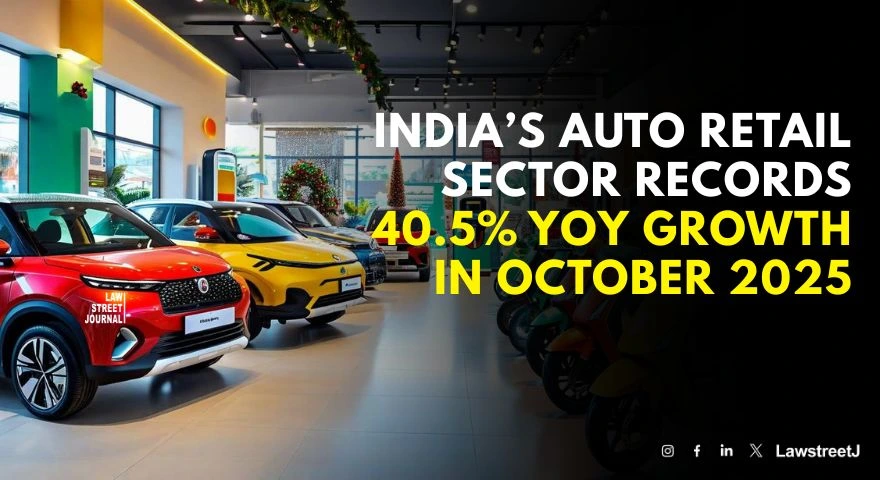New Delhi: India’s automobile retail industry closed October 2025 with its highest-ever monthly numbers, registering a 40.5% year-on-year jump and touching 4.02 million units. The latest figures, issued by the Federation of Automobile Dealers Associations (FADA), show broad expansion across every major vehicle class. A long festive season, combined with the rollout of GST 2.0, played a major role in shaping the month’s performance. Unlike September, which remained slow because dealerships were adjusting to the GST 2.0 transition, October brought a sharply different trend. The festive period was unusually long this year, stretching for 42 days and covering Dussehra and Diwali. Dealers across multiple states reported that the extended window created sustained footfall and helped clear delayed purchases that had been held back during the tax transition.
FADA President C.S. Vigneshwar described the month as a significant point for the sector, noting that the combination of tax changes and festival-linked buying cycles pushed demand well beyond earlier expectations. According to FADA’s data, two-wheelers saw their strongest month ever, and passenger vehicles crossed the five-lakh monthly milestone for the first time.
Segment-wise Performance: Strong Growth Across Categories
The FADA report lists the following numbers for October 2025:
- Two-Wheelers: Sales rose 51.76% YoY to 31.5 lakh units, the highest monthly total recorded by the segment.
- Passenger Vehicles: At 5.57 lakh units, the segment grew 11.35% YoY and crossed the five-lakh threshold for the first time.
- Commercial Vehicles: Growth stood at 17.7% YoY, supported by rising freight movement and infrastructure-linked activity.
- Three-Wheelers: This segment posted 5.4% YoY growth, reflecting consistent urban transport demand.
- Tractors: Retail numbers increased 14.2% YoY, aided by rural market conditions and seasonal farm requirements.
- Construction Equipment: The segment rose 30.5% YoY, reflecting continuing infrastructure expansion.
GST 2.0: Key Legal and Regulatory Changes
A large part of the shift in buyer behaviour is connected to the GST 2.0 framework that took effect on September 22, 2025. The revised tax structure brought down the GST rate on entry-level two-wheelers and small passenger cars from 28% to 18%. These changes came through amendments made to the Central Goods and Services Tax Act, 2017, and the Integrated GST Act, based on decisions taken during the GST Council’s 53rd meeting. The new rules also simplified inter-state compliance for dealerships. Dealers previously handling registrations across multiple states had faced procedural delays, but the updated system reduced paperwork and streamlined credit adjustments. FADA’s internal evaluation indicated that the sector adapted quickly, with minimal disruption to supply chains.
Vehicle registration and safety norms continued under the provisions of the Motor Vehicles (Amendment) Act, 2019, which remains the governing legal framework for dealerships, licensing, and compliance. The October sales surge, therefore, fell fully within the parameters of existing statutory requirements. The October numbers arrive after a challenging period marked by regulatory transitions and lingering post-pandemic effects. Analysts tracking the retail sector now expect the positive momentum to carry forward into the next quarter, supported by expansion in both rural and urban markets.
Demand from rural regions continues to support two-wheeler and tractor sales, especially in states with favourable agricultural output this season. Commercial vehicle sales have picked up pace due to increased freight movement linked to active construction and logistics cycles. Digital retailing, including online booking and hybrid dealership models, has been increasingly absorbed into standard sales operations. Policy stability, particularly around GST, is expected to help maintain predictable costs for both dealers and customers.
One section drawing notable interest is electric mobility. EVs made up 6.2% of total retail sales in October, with urban markets forming the bulk of purchases. Dealers reported steady inquiries for electric two-wheelers and compact EV passenger vehicles, driven partly by lower operating costs and the arrival of several new models. The Ministry of Heavy Industries is scheduled to publish updated guidelines under the FAME-II scheme by December 2025. Any revisions to subsidy rules or compliance standards may influence future pricing strategies and product availability in the EV category.
Operational Guidance and Inventory Management
FADA has advised auto retailers to monitor inventory closely in the coming months. Sudden jumps in demand during the festive season often lead to uneven stock distribution across states and districts. The association has urged dealers to track localised product preferences, such as rising interest in compact SUVs and fuel-efficient models, while maintaining balanced inventory cycles to avoid post-season pressures. Dealers have also been briefed on assessing supply chain timelines, particularly for high-volume two-wheeler and passenger vehicle models that saw rapid movement during October. The focus remains on ensuring stable availability while avoiding overstocking after the festival period.
The 40.5% year-on-year rise in auto retail sales makes October 2025 a milestone month for the sector. The combination of GST 2.0, a prolonged festive season, and a broad rise in consumer activity contributed to a record-breaking performance. With statutory frameworks stable and market sentiment showing improvement, the industry enters the next quarter with momentum and clarity.









